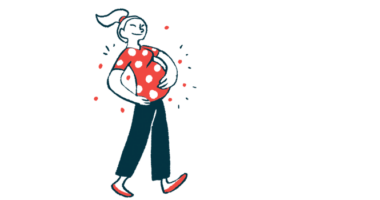Why I admire my now beautifully flawed body
The scars that tell stories about my life with PNH, as well as my strength

The other day, as I was standing in front of my bathroom mirror, I began to pay attention to my scars. They’ve been on my body for so long that they’ve become a part of me. Many days, as I get ready, I don’t even notice my scars as something that shouldn’t be there. This day, I did.
I have one scar on my right chest, about 10 inches below my clavicle. I rubbed my fingers along the thick, 5-inch mark. As I focused on it, I thought about the story behind this different texture attached to my skin, and how it got its place.
While I was fighting aplastic anemia and paroxysmal nocturnal hemoglobinuria (PNH), I was given a port, which is a great way for phlebotomists to draw blood once your veins have had enough of the poking and prodding.
The port worked so well — until it didn’t. I was thankful for it in the beginning because I no longer had to prepare mentally for another day of the phlebotomist digging around until my vein stopped rolling, or simply trying to find a decent vein.
Man, I should have named this port! Let’s call her Bria.
One day, Bria became infected. Every time she was accessed by a needle, I became sick, running a fever, coughing all night, and experiencing severe fatigue. After spending countless nights in the emergency room, I began to believe that something was wrong with Bria.
ER visits were always brutal. Any time I could avoid them was a win. After becoming sick and visiting the ER for the 10th time, I consulted with my doctor, which led to the end of Bria. In the wake of her passing, a scar developed at the site where Bria had been removed.
I also have twin scars on my back hip bones. With aplastic anemia and PNH, doctors perform a bone marrow biopsy to check the patient’s amount of marrow. In this procedure, a needle is used to access the bone marrow. I’ve had around six to eight of these biopsies, including three while awake, and these created my twin scars.
Turning around in the mirror, I lifted my shirt just enough to see my back hip bones. I rubbed my fingers along the heightened skin, which is circular and dark. That reminded me of my first bone marrow biopsy. I wasn’t fully prepared for the procedure and didn’t realize what it would involve. I also had no clue that I’d much prefer being asleep during them.
The doctor gestured Mom and me to the procedure room. I lay face down on a hard table covered with the noisy, white paper. I could hear the doctor at my side, moving things around as he prepared. With my face down, I wasn’t able to see anything. I preferred it that way.
My mom kneeled beside my bed and, with her hand on my back, began to pray. As she looked up, she saw the long needle and tried hard not to freak out. She was just comprehending what was about to happen.
I felt the pressure as the doctor gathered bone marrow from my back hip bone. The procedure took no longer than an hour, and afterward, I sat on the edge of the bed in silence, unable to believe I’d tackled one of the weirdest moments in my life.
Little did I know, that was just the beginning.
My scars have so many stories. They’ve lived so much life on my body. As I finished admiring them in the mirror, I began to smile. I was full of joy because my scars reminded me of my strength, determination, persistence, faith, and will to keep fighting for my life.
I’m proud of my beautifully flawed body.
Note: PNH News is strictly a news and information website about the disease. It does not provide medical advice, diagnosis, or treatment. This content is not intended to be a substitute for professional medical advice, diagnosis, or treatment. Always seek the advice of your physician or other qualified health provider with any questions you may have regarding a medical condition. Never disregard professional medical advice or delay in seeking it because of something you have read on this website. The opinions expressed in this column are not those of PNH News or its parent company, Bionews, and are intended to spark discussion about issues pertaining to paroxysmal nocturnal hemoglobinuria.








